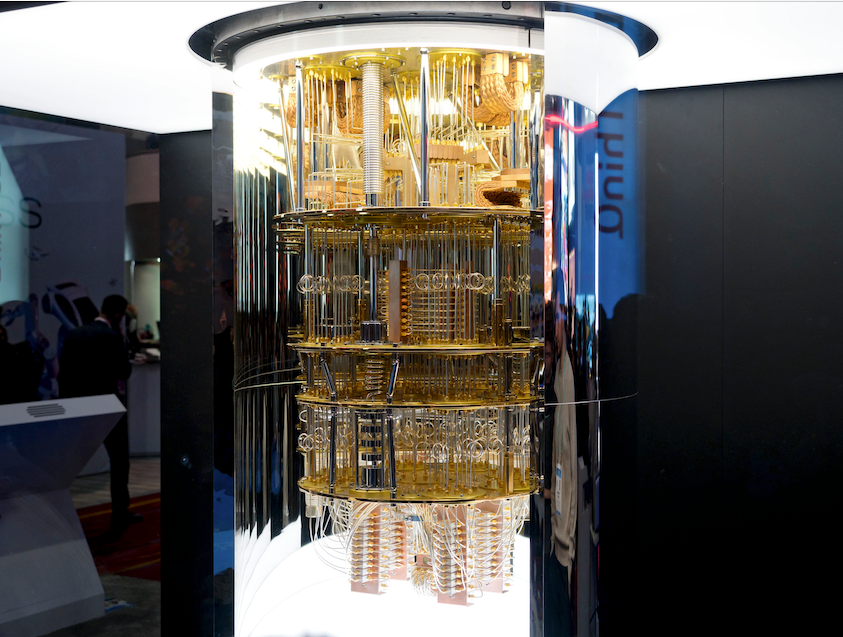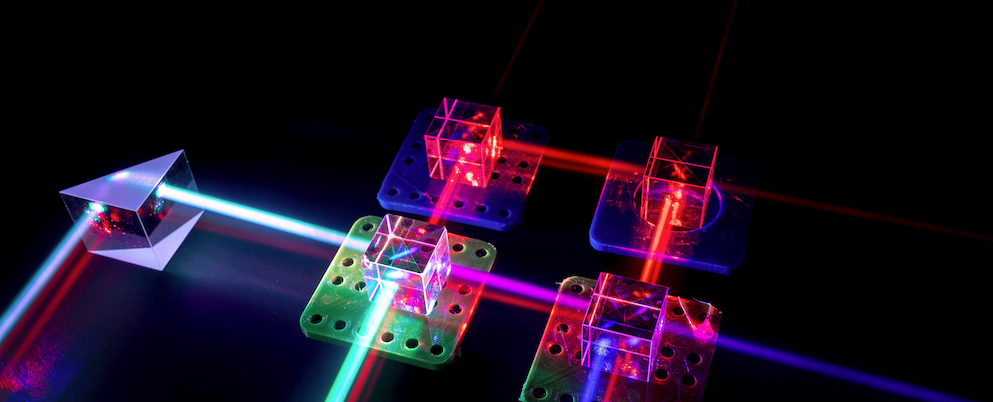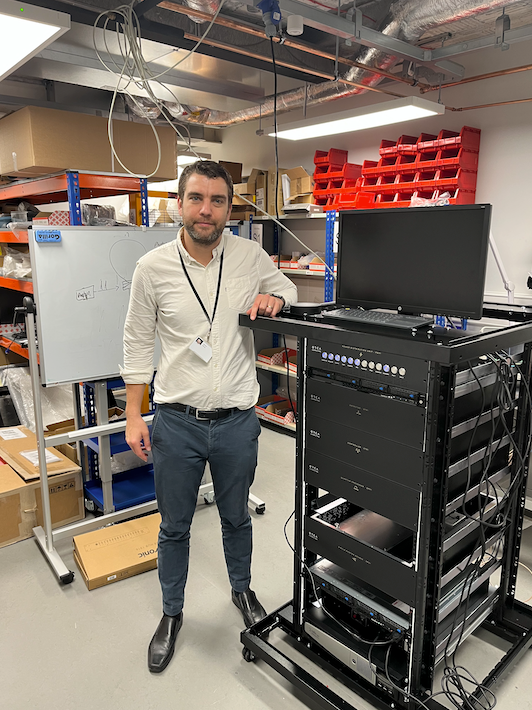
With the publication in March 2023 of its National Quantum Strategy, the UK Government has signalled its intention to be an early mover in quantum technologies with a wide slate of investments in the sector.
In many ways the arc of development set out is a clear example of what defence procurement should be: heavy investment early on, subsidising risks for research partners while allowing private sector institutions room to innovate as the technology grows in sophistication. At an end point, customers like the UK Ministry of Defence (MoD) are able to communicate their requirement to contractors and select finished systems that meet the specification.
The variety of vendors in the quantum technology space should then meet the target without the customer needing to start from base principles.
Where are we in the arc now? In a way that feels typically quantum, we are everywhere and nowhere at once. There are a lot of different researchers in the field, showing varied and interesting approaches to quantum computers.
There is significant investment from public bodies, including the announcement made by the UK through its Department for Science, Innovation & Technology Department, as part of the National Quantum Strategy.
A range of firms are offering access to quantum computers through a software-as-a-service model, as well as a handful selling the machines itself. ORCA computing has a photon-based quantum computer with eight qubit-equivalents that they offer less than $1m, and indeed have sold such a computer to the MoD – the first purchase of a quantum computer to the UK Government, bought in June 2022 and delivered in February 2023.
However, despite the investment, the variation in working active theories and research approaches, and the manifest technologies that have become available on the market, there is one basic target that hasn’t yet been reached. So far, no quantum computer has been invented that can achieve the better results than a classical computer in the same amount of time. That is, we have not yet achieved quantum supremacy.
This is deterring no-one, and the attitude to investment at this stage is one of preparation.
Getting quantum ready
“It’s not like you can get your team of programmers to one day all of a sudden start programming a quantum computer,” said Richard Murray, CEO of ORCA Computing, speaking of the challenges research institutes will have adjusting to future advances in quantum computing.
“It needs a complete rethink about how you approach problems, how you structure your data, what types of problems you might solve. So that takes a lot of a lot of education, but people are working, like our customers, with real quantum computers to do that. But the computers themselves aren’t powerful enough to do anything classical computers can’t do.”
UK’s MoD was the first customer of ORCA computing, buying up the company’s compact and rugged photon technology quantum computer. Because the fundamental particle at the heart to ORCA’s PT-1 machine is essentially light, there is no need to supercool the processor at the heart of the quantum operations.
“Reading books and journals is no substitute for practical experience.”
Stephen Till, senior fellow of the MoD’s Defence Science and Technology Laboratory.
This means they can produce working units at a vastly reduced size, and instead of sitting in a glass chandelier in a frozen environment the size of a shed, the computer takes up a few shelves on a 19-inch rack. With the keyboard and monitor on top it stands over 4.5ft high, but it is indistinguishable from a normal computer in all other ways. Indeed, every component it is made from is available off the shelf and found throughout the telecoms industry.
According to GlobalData’s ‘Thematic Intelligence: Quantum Computing’ report, there are a variety of ways to use photons as a means of quantum computation. The effect can be achieved by splitting up light beams on a tabletop or inside a silicon chip, and silicon photonics is an emerging technology in which data is transferred between silicon chips by optical rays, carrying far more data in less time than traditional electrical conductors. Semiconductor manufacturers are able to etch thousands of optical components onto single wafers of silicon, ushering in an era of silicon photonics with the prospect of breaking the mould in quantum computing.
Stephen Till, senior fellow of the MoD’s Defence Science and Technology Laboratory (DSTL), echoes Murray’s views on the benefits to organisations of early adoption in quantum computing, and the challenges that are necessary to tackle in building institutional knowledge.

“Learning how to programme and use a quantum computer is just the same as programming and using a digital machine: it is vital to experiment with writing programmes and learning from mistakes. Reading books and journals is no substitute for practical experience,” said Till.
“Also, it is important to have as targets the solution of problems of real interest to the enterprise; this allows digital computing background to be exploited and, if the problems are well chosen, demonstrates the potential future value of quantum processing to the stakeholders and decision makers who determine future investment for the enterprise.”
Murray points out that in ORCAs work, the focus of his activity now is to define problems in ways that can be approached by the quantum computer. “What success looks like for us is: who cares about colossal quantum volume? Find the first valuable application which benefits from a quantum system. We’re not there yet, but that’s what we think success looks like.
“Once you’re in that landscape …you’re in the landscape of high-performance computing. There have been debates about what the right benchmarking is in the high-performance computing world, but at least those benchmarks are related to real problems.”
The UK Government’s first quantum computer
In describing the specification, the MoD required when purchasing the ORCA PT-1 quantum computer, Till was clear about quantum computing’s primary practical military application being in intelligence, surveillance and reconnaissance (ISR), and that these processors are ideally deployed toward the edge of operations.
“Currently, only one type of processor, the ORCA PT-1 series of machines, is potentially deployable in this way. It is compact, man-portable, requires only a 240V AC electricity supply and does not require cryo-cooling.
“Edge computing and quantum computing have not been considered together before,”
Stephen Till, senior fellow of the MoD’s Defence Science and Technology Laboratory.
“Edge computing and quantum computing have not been considered together before,” said Till, speaking of the practice in edge-computing of moving the majority of the processing requirements for incoming data to the edge of an information system, so that data is processed quickly and put into practice where it is collected, at the site of the platform. The requirements for such systems are naturally in competition with other platform components for size weight and power.
“Not only do mainstream quantum processors require cooling to milli-K temperatures with large, power-hungry dilution refrigerators, they also have to be shielded from magnetic, electric, vibrational, and other sources of ‘noise’ which rapidly destroys the quantum information carried by the qubits in the processor.
“Many people believe we will not be able to deploy ORCA processors but there is evidence that deployment, at least to benign environments, is feasible even today. Because photons interact very little with their environment, quantum photonic processors do not need special shielding from noise with the exception of vibrational noise and excessive temperature gradients.
“An ORCA PT-1 has been transported by road between locations and successfully operated when it reached its destination.”
Till points out that other quantum technologies also support the conclusion that deployed operation in benign environments is feasible, citing cold atom gravity gradiometer that was transported over a hundred miles by road and subjected to accelerations at several times the force of gravity, in 2016.
“[It] worked successfully, first time, at its destination. There are similarities in component sub-systems … of the two devices and it is not unreasonable to conclude that quantum technologies may not all be as fragile as is generally assumed,” said Till.

Following the purchase from ORCA, Till is sometimes credited with saying that he hopes to see a quantum computer in the back of every Land Rover, an expression Murray is fond of because it points to the hardwearing and condensed characteristics of their machine. Asked about the aspiration now, Till expressed a more finessed view.
“A quantum computer in the back of every command vehicle, with a dedicated, trained operator is feasible, affordable and possible during the next 5-10 years. Deployment of quantum processors in this way would increase the pace of operations and improve the quality of decision support tools or make such tools possible for the first time.
“For instance, the determination of optimal courses of action [CoAs] is a difficult combinatorial problem. As the problem size increases, the number of potential CoAs increases so rapidly that they cannot be solved using a digital computer.
“Problems are still solved manually using tables and drawing on experience. We showed in 2022 with PA Consulting that quantum processors offer a potential machine speed solution not available today.”
Defence applications of quantum computing
Working with PA Consulting in 2022, DSTL tested a hybrid classical/quantum computer against human competition to answer tangible questions: asking one case where the best place is for communications assets to ensure a resilient network; and in another use-case, seeking to know how to best use limited resources and their constraints against a to-do list.
Both examples were problems that rapidly scale to a complexity beyond the capability of humans or classical computing solutions, but with a classical computing structure for formulating and presenting the data and a quantum processor for completing the calculations, the hybrid system won out, with the feedback illustrating that the system makes decision-making better and faster.
“To my knowledge, this is the first piece of work to demonstrate quantum benefit using a NISQ machine to solve militarily important problems and that will build confidence and underpin continued investment in quantum information processing by the UK MOD and Government.”
Stephen Till, senior fellow of the MoD’s Defence Science and Technology Laboratory (DSTL)
“The two use cases PA has explored have shown quantum benefit can be derived even with today’s Noisy Intermediate Scale Quantum (NISQ) processor technology,” said Till. “With further developments in system architectures and hardware, the work has increased our confidence that quantum information processing will help solve many of MoD’s important challenges.
“To my knowledge, this is the first piece of work to demonstrate quantum benefit using a NISQ machine to solve militarily important problems and that will build confidence and underpin continued investment in quantum information processing by the UK MoD and UK Government.”
Defence problems assailable through quantum computing are mainly ones of optimisation and machine learning, and are a frequent occurrence in ISR, according to Till. “Typical examples are the planning/re-planning of communications networks for deployed reconnaissance patrols or the determination of optimal courses of action given a set of possible choices.”
The list of possible exploits for quantum computing in defence goes on: designing resilient and efficient military platforms; predicting new armour materials or batteries; and running large scale accurate war-games (or crisis management simulations). However, Till cautions that these require fault tolerant, scalable quantum computers “and we do not know when, or if, such machines will be available. Engineering a fault tolerant, scalable quantum computer is a huge engineering challenge.”
A well discussed approach uses the concept of error correction, using groups of qubits to defeat random noise in the system, however there is an unresolved debate about whether error correction in this way is allowed by the fundamental laws of physics. The current limited experimental suggests the error rate in a system scales with the number of qubits.

“If this is a true result, then true quantum computers will not be possible. Insufficient is known about the behaviour of groups of qubits because it is not possible to simulate systems comprising more than about 42 qubits before a digital computer runs out of memory resources.
“It is for this reason that it is important to understand the practical possibilities of using NISQ machines. It is almost certain that future NISQ processors will have more ‘quieter’ qubits with greater connectivity between them and able to perform data input/output at much higher rates than currently.”
Till stated that organisations that have invested in understanding what can be done using quantum optimisation and quantum machine learning will be in a strong position compared to those who have held back, waiting for fault tolerant, scalable quantum computers.
“We know that defence has many problems addressable with optimisation and machine learning methods and its current investment will only benefit future operations.”
Government investment in quantum computing
Government has the resources to be an early adopter of cutting-edge technologies, which may help spur innovation and prove the technologies’ worth to businesses and consumers. The Small Business Research Initiative (SBRI) and the National Security Strategic Investment Fund (NSSIF) are just two examples of how the UK Government has used procurement to spur innovation, which in turn has improved services while also helping small businesses and stimulating markets.
“Nearly £1.1bn has been spent since 2014.”
NSSIF has spent £2.6m in R&D contracts with quantum enterprises, stimulating development in the UK quantum ecosystem, as part of its plan to provide insight and access to quantum computing.
The sphere of defence is one of the most important areas in which the UK Government operates as an early adopter of new technology. This has provided the MoD with the ability to evaluate upcoming issues, get an understanding of applications and potential paths to exploitation, and make steps to becoming quantum ready.
When the National Quantum Technologies Programme (NQTP) was established in 2014, MoD was an integral participant. Early on, it highlighted the defence sector’s need for quantum technologies in the areas of sensing, imaging, and timing, with more prospects in communications and computing to follow.

The NQTP brings together experts from government, universities, and businesses to create a unified strategy for quantum science and technology at the national level. It hastens the spread of these innovations, guarantees an independent capacity for national security, and propels the economic growth of the United Kingdom. Nearly £1.1bn has been spent since 2014.
The initiative is now in its second phase, with the end goal of creating workable timing, sensing, imaging, communications, and computing technologies by 2025. Defence has contributed its own science and technology to this project and is now drawing on the programme’s resources and knowledge in return. The MoD can now predict future challenges, investigate potential areas of use, and map out possible avenues of exploitation.







